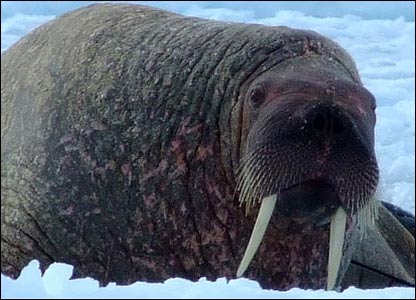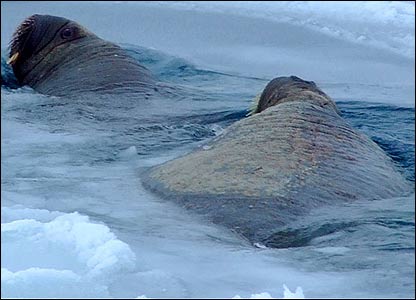Journey of 'tailing' of Arctic walrus
Zoologists in Greenland and Denmark are working on an extremely interesting study: tracking the habits and activities of long-fanged walrus species in the Arctic. However, this amazing journey also encounters countless hardships.

Walruses (also known as moons) are a large marine animal that lives in the Arctic region. (Photo: BBC)
The walrus (also known as the moc) is a large marine animal living in the Arctic that looks a bit like a seal but is larger in size and has two long fangs.

The group of zoologists, led by Mr. Mikkel Villum Jensen, had to use canoes, cross the sea ice, approach the herds of hippos to shoot tracking satellites at their tails. (Photo: BBC)

The walrus usually sleep on icebergs. (Photo: BBC)

The easiest way to shoot satellite cards is when the walrus is lying relaxed on the ice like this. (Photo: BBC)

Despite the large body, the walrus was extremely shy, it was only necessary to see a strong and glossy movement of people who hurriedly scrambled down the water to flee. (Photo: BBC)

A walrus was very old and slow. (Photo: BBC)

Sticking to the hippocampus is a very arduous task for zoologists. (Photo: BBC)

After all the hard work, they finally shot satellite cards into 8 walruses. (Photo: BBC)

This walrus was shot satellite (red knob) into his neck. (Photo: BBC)
In-depth research on walrus species is coordinated by the Greenland Institute of Natural Environment and Danish Center for Environmental Research.
The group of zoologists, led by Mr. Mikkel Villum Jensen, had to use canoes, cross the sea ice, approach the herds of hippos to shoot tracking satellites at their tails. After weeks of hard work, they finally ' hunted ' 8 timid fangs.
The purpose of this study is to track the behavior, movement and journey of walrus in the summer, through signals from satellite cards that have been shot at them.
Thu Hien
- Walrus migrated massively from the North Pole to the United States
- Strange story: Tens of thousands of walruses land massively on Alaska beaches
- The walrus fled because of the ice melt in the north pole
- Arctic: Melting ice causes the walrus to die
- The extraordinary journey of the Arctic fox
- Video: Journey by three round trips to the Moon of the Arctic Circle
- Shocked, snow foxes exceeded 3,500km in just 76 days
- 10 great photos of permafrost
- Tens of thousands of walruses lined up on the Alaskan coast
- Interesting facts about animals living in the Arctic
- Why are tens of thousands of walruses stuck on Alaska beaches every year?
- Impressive photos in the polar region
 Animal 'suffering' after hibernation
Animal 'suffering' after hibernation Why do goats climb well?
Why do goats climb well? Scientists were surprised to see chimpanzees eating turtles
Scientists were surprised to see chimpanzees eating turtles Giant catfish died deadly due to drought in Thailand
Giant catfish died deadly due to drought in Thailand